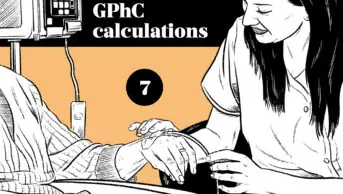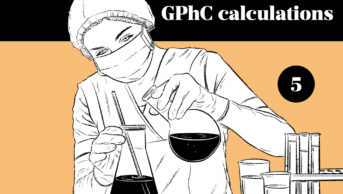
Charlotte Gurr
As we stand on the threshold of a pivotal moment for the profession — with pharmacists joining the General Pharmaceutical Council (GPhC) register in 2026 as independent prescribers — the skills and knowledge required to accurately perform pharmaceutical calculations has never been more critical.
The Common Registration Assessment (CRA)1 is not just another hurdle before entering the register, it is essential that all pharmacists can demonstrate independent, reliable and error-free calculation skills to ensure patient safety and maintain public trust.
With the added responsibility of prescribing, pharmacists may be required to calculate complex dosing regimens and face greater accountability, which makes accuracy in calculations even more essential. This includes — to name a few— medicines with a narrow therapeutic index or other high-risk drugs, dose adjustments for insulin, anticoagulants, opioids, chemotherapy calculations and paediatric or neonatal dosing. This competency is equally vital when preparing intravenous infusions or working in urgent care —where rapid and precise calculations are critical.
Pharmacy students typically possess good mathematical skills, and our role as university tutors is to guide them in linking these skills to clinical scenarios and demonstrating the relevance of calculations to practical applications. We start with simple contexts and progressively spiral complexity throughout the four-year curriculum via varied teaching methods, simulated cases and digital tools to support learning. At Kingston University, calculation competence is assessed in multiple formats. Students are assessed annually at each level in dedicated calculation papers to ensure they meet progression requirements and complemented through the integration of calculations into other assessment formats, objective structured clinical examinations and simulated learning.
As students graduate and enter their foundation year, they can learn from a wider range of real-life cases, across different sectors. The GPhC independent prescriber assessment framework, published in September 2025, outlines broad content areas that are continually updated, which “allows the CRA to remain dynamic and responsive to emerging pharmacy trends, ensuring that all content is contemporary and reflective of the expectations for pharmacists at the point of registration”1. As a result, the assessment is designed to evaluate trainees’ ability to apply their knowledge to scenarios that go beyond what is taught at the university level.
A final checkpoint through a comprehensive national exam after the training year remains essential to ensure consistency and competence across the profession.
Minutes from a GPhC council meeting, held on 20 February 2025, confirmed that the current assessment format will remain unchanged until at least the 2026 cycle, with their ultimate objective to enhance training quality assurance to a standard that might eventually remove the need for the registration assessment2.
The committee also discussed moving the calculation assessment to the end of the MPharm course or even earlier. However, in my opinion, this conflicts with the goal of allowing trainees to gain practical experience during the registration year before being assessed. Separating the clinical and calculations papers into distinct assessments could weaken their intended integration, as true readiness requires demonstrating both clinical and numerical competency together, which reflects real pharmacy practice.
Another proposal discussed by the committee suggested that the assessment should be offered on a flexible “on-demand” model, which allows trainees to choose when and where to sit the exam within a set timeframe. I am in favour of this approach, as it is contemporary, inclusive and supportive of trainee autonomy. However, it could be more complex for the regulator and raise questions about logistics, quality assurance and the standardisation of questions. The GPhC committee estimated that maintaining such a model would require expanding the question bank by around 4,000 questions2.
Pharmacists’ responsibilities range from determining the correct amount to dispense to writing prescriptions and accurately calculating doses in a timely manner, while considering complex factors such as body weight, renal function and other pharmacokinetic and clinical considerations. This requires a good understanding of science, the confident use of maths and effective clinical judgment.
Errors in calculations — if not identified early — can lead to serious consequences. I do not want to dwell on tragic cases, but it is important to recognise that even small mathematical mistakes can cascade into significant outcomes. These examples should be used as a point for reflection — in fact, reflective practice is crucial in pharmacy practice. Such errors can occur among various practitioners, especially those who are new to practice. For example, junior doctors are more prone to making errors than their senior counterparts, particularly when prescribing weight-based doses, intravenous infusions or paediatric medications3.
An analysis of dosage calculation errors, published in 2022, highlighted 10- or 100-fold miscalculations, unit confusion and incorrect concentration or rate entries on infusion pumps4. Medication errors occur roughly three times more often in paediatric patients since dosing requires calculations based on body weight or body surface area, in addition to considering age-appropriate formulations. This individualised approach increases the risk of errors5. Overdose and underdose miscalculation have also been attributed to confusion between units (e.g. milligram, gram, microgram) or dosing expressions such as mg/kg versus mg6.
The Reason’s model of accident causation, also known as the ‘Swiss cheese model’, identifies active failures as direct, unsafe actions or omissions with immediate effects, such as a prescriber’s dosing miscalculation7.
Pharmacists act as crucial gatekeepers in the healthcare system and form a crucial defence by detecting and preventing such errors before they reach patients. As their responsibilities expand to include prescribing, pharmacists’ accuracy in calculations and clinical judgment becomes even more vital. They need to be able to fulfil both their prescriber and safety gatekeeper roles for other healthcare professionals. Accordingly, demonstrating calculations competency before joining the prescriber register remains integral part to ensure safe and effective practice.
The Pharmaceutical Journal Foundation trainee ‘hub’
This collection of resources has been created to support preparation for the General Pharmaceutical Council registration assessment.
By visiting here, you can access advice on how to plan and structure revision time effectively or practice the different types of pharmacy calculations that will feature in the exam.
To help revision preparation against the learning outcomes related to therapeutic approaches, links have been provided to our clinical condition ‘hub’ pages where expert authored content can be accessed on a range of different topics.
Find out more here.
- 1.Common Registration Assessment framework. The General Pharmaceutical Council. 2025. https://assets.pharmacyregulation.org/files/2025-09/Common-Registration-Assessment-framework-for-sittings-in-2026.pdf?VersionId=kyTwR9mQ6gvagIJtA0h88Kj8uHGsqFEo
- 2.Council meeting 20 February 2025. The General Pharmaceutical Council . February 2025. https://assets.pharmacyregulation.org/files/2025-02/gphc-public-council-papers-february-2025..pdf.pdf?VersionId=RI9mS5oKguQgsW0GwoKKLEvU62SXcjWg
- 3.Kalfsvel L, Wilkes S, van der Kuy H, et al. Do junior doctors make more prescribing errors than experienced doctors when prescribing electronically using a computerised physician order entry system combined with a clinical decision support system? A cross-sectional study. Eur J Hosp Pharm. 2023;32(1):41-45. doi:10.1136/ejhpharm-2023-003859
- 4.Mulac A, Hagesaether E, Granas AG. Medication dose calculation errors and other numeracy mishaps in hospitals: Analysis of the nature and enablers of incident reports. Journal of Advanced Nursing. 2021;78(1):224-238. doi:10.1111/jan.15072
- 5.Parry C. Fatal mistakes: why do ten-fold medication errors in children keep happening? The Pharmaceutical Journal. April 22, 2021. https://pharmaceutical-journal.com/article/feature/fatal-mistakes-why-do-ten-fold-medication-errors-in-children-keep-happening
- 6.Tse Y, Tuthill D. SP5 Tenfold medication errors in children – Welsh paediatric surveillance unit study 2017–9. Arch Dis Child. 2020;105(9):e3.1-e3. doi:10.1136/archdischild-2020-nppg.5
- 7.Coon R, Holden K. Understanding human factors in patient safety when prescribing. The Pharmaceutical Journal. September 13, 2024. https://pharmaceutical-journal.com/article/ld/understanding-human-factors-in-patient-safety-when-prescribing
1 comment
You must be logged in to post a comment.
You may also be interested in

Medication maths: infusion rates

Medication maths: calculations involving molecular weight

As a non-pharmacist who failed maths O' Level (twice), I am not qualified to comment, but I have to ask: shouldn't the same requirements apply to all prescribers, or at least to all medical practitioners?